Tone Ranger 1-Ch Head /Combo
Amps
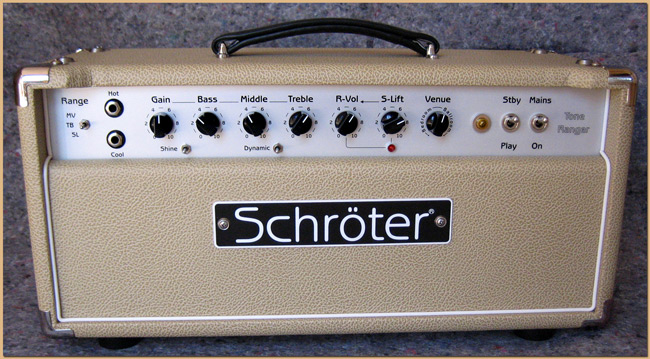
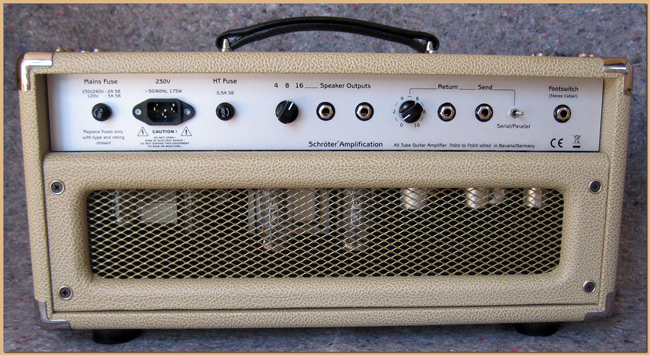
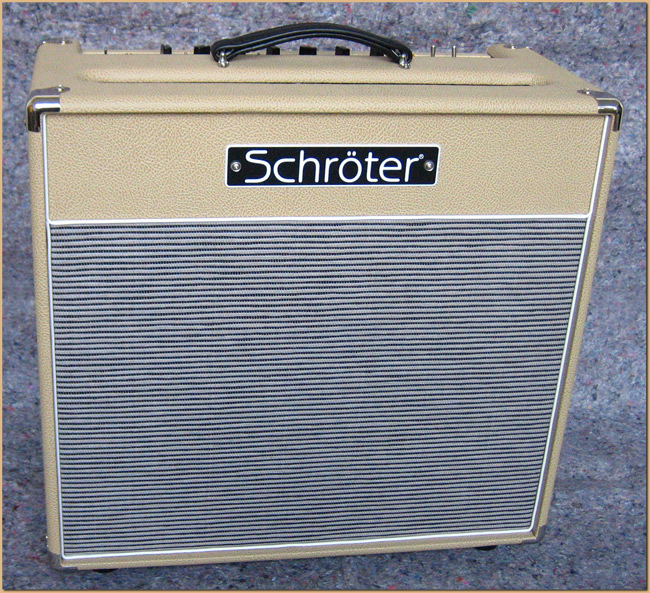
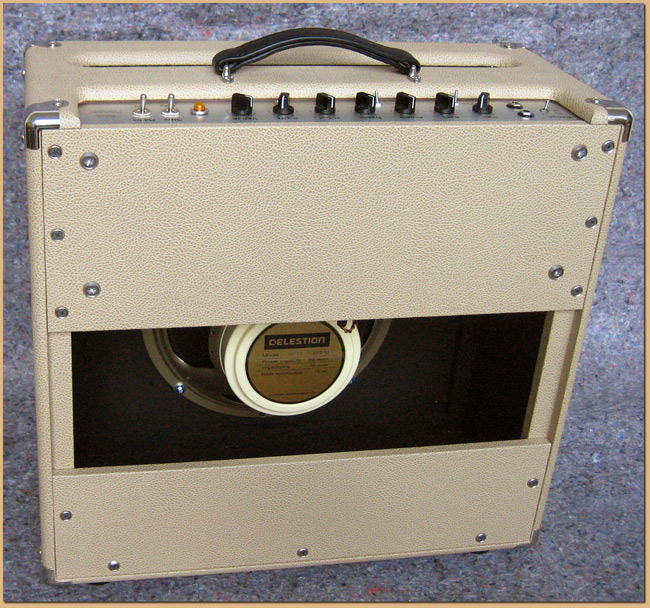
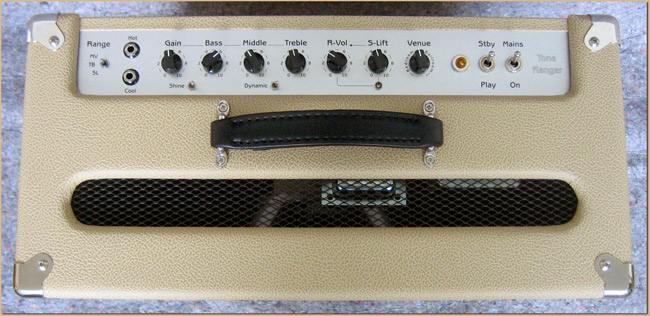
Device Type
All-tube guitar amp head and combo, 1-channel, 3 basic sounds preselected with serial / parallel switchable effects loop, 2 volumes footswitchable, completely made by hand in Germany, wired point to point
All-tube guitar amp head and combo, 1-channel, 3 basic sounds preselected with serial / parallel switchable effects loop, 2 volumes footswitchable, completely made by hand in Germany, wired point to point
Power 50W class A / B push-pull output, power supply tube rectification
Tubes
Power tubes 2 x EL34B-STR (duet,TAD )
Preamp tubes 3 x ECC83-Cz (TAD ), 1 x 12AX7 Tung Sol
Rectifier tube GZ34
Chassis
Aluminum, front and back plate natural anodized aluminum,
Pre-amp tubes shielded with sheet metal caps and secured against slipping, rectifier tube and power amp tubes secured with clamps
Head
15 mm multiplex, cover imitation leather, metal caps nickel plated on all corners, handle imitation leather metal reinforced, rubber feet
Dimensions (WxHxD / mm): 505 x 230 x 225
Weight: 14.9 kg
Combo 1x12
12 mm multiplex, cover imitation leather, metal caps nickel plated on all corners, handle imitation leather metal reinforced, rubber feet
Dimensions (WxHxD / mm): 550 x 510 x 260
Mass:
with Celestion NEO Creamback 20.4 kg
with Celestion Creamback 22.0 kg
Equipment
- Power cable
- Protective cover
- Tone Ranger S-Lift Footswitch with 6 meter connection cable
- Tone Ranger Pedal Footswitch (surcharge)
Tubes
Power tubes 2 x EL34B-STR (duet,
Preamp tubes 3 x ECC83-Cz (
Rectifier tube GZ34
Chassis
Aluminum, front and back plate natural anodized aluminum,
Pre-amp tubes shielded with sheet metal caps and secured against slipping, rectifier tube and power amp tubes secured with clamps
Head
15 mm multiplex, cover imitation leather, metal caps nickel plated on all corners, handle imitation leather metal reinforced, rubber feet
Dimensions (WxHxD / mm): 505 x 230 x 225
Weight: 14.9 kg
Combo 1x12
12 mm multiplex, cover imitation leather, metal caps nickel plated on all corners, handle imitation leather metal reinforced, rubber feet
Dimensions (WxHxD / mm): 550 x 510 x 260
Mass:
with Celestion NEO Creamback 20.4 kg
with Celestion Creamback 22.0 kg
Equipment
- Power cable
- Protective cover
- Tone Ranger S-Lift Footswitch with 6 meter connection cable
- Tone Ranger Pedal Footswitch (surcharge)
- Tone Ranger Solo Pedal Footswitch (surcharge)
- Flightcase medium heavy version (surcharge)Sound & Character Traits of the Schröter® Tone Ranger
The Schröter Tone Ranger is a single-channel, thoroughbred all-tube amp. Top and combo are technically identical. The guitar signal "flows" from the input jacks to the speaker outputs only through point-to-point wired circuitry and comes in contact with nothing but resistors, capacitors, tubes and metal in the form of leads and switch contacts, just like vintage amps case is.
Neither in nor on the (!) signal path occur semiconductor devices in any form!
It owes its name to its 3-stage range switch, which determines its basic sound.
Depending on your preference, you move into the SL position in the legendary Marshall Super Lead range, in the MV position you will find yourself back in the historically following Marshall Master Volume era and on TB, VOX AC 30 Top Boost friends will find their favorite.
The preselected base sound can now be significantly shaped into transparency, cleanness, density and compression with the three-stage switches Shine and Dynamic, so that the limits of the sound ranges with regard to the distortion intensity largely disappear.
The Hot and Cool inputs react significantly different when decreasing the guitar volume to whether or not it is equipped with a treble bleed capacitor, which negates its utility as a dull high or low jacks.
Due to the interaction of the Rhythm Volume control (and Solo Lift) with the Venue control, the Tone Rangers' distortion intensity, tone density and compression are completely volume-independent. Its 50W power amp makes it possible to deliver loud clean sounds, while heavy crunch appears absolutely dense and "cranked up" even at room volume.
In addition comes his parallel / serial switchable effect loop and a second, foot switchable volume, which stands out clearly from other single-channel amps.
These features, which are sometimes unusual for a single-channel amp, make the Tone Ranger - especially in conjunction with the optional Tone Ranger Pedal and Tone Ranger Solo Pedal tuned to it - a highly flexible base amp for effect pedals. However, with its pure tone you will immediately feel like enjoying it with nothing but a guitar!
The Schröter Tone Ranger is a single-channel, thoroughbred all-tube amp. Top and combo are technically identical. The guitar signal "flows" from the input jacks to the speaker outputs only through point-to-point wired circuitry and comes in contact with nothing but resistors, capacitors, tubes and metal in the form of leads and switch contacts, just like vintage amps case is.
Neither in nor on the (!) signal path occur semiconductor devices in any form!
It owes its name to its 3-stage range switch, which determines its basic sound.
Depending on your preference, you move into the SL position in the legendary Marshall Super Lead range, in the MV position you will find yourself back in the historically following Marshall Master Volume era and on TB, VOX AC 30 Top Boost friends will find their favorite.
The preselected base sound can now be significantly shaped into transparency, cleanness, density and compression with the three-stage switches Shine and Dynamic, so that the limits of the sound ranges with regard to the distortion intensity largely disappear.
The Hot and Cool inputs react significantly different when decreasing the guitar volume to whether or not it is equipped with a treble bleed capacitor, which negates its utility as a dull high or low jacks.
Due to the interaction of the Rhythm Volume control (and Solo Lift) with the Venue control, the Tone Rangers' distortion intensity, tone density and compression are completely volume-independent. Its 50W power amp makes it possible to deliver loud clean sounds, while heavy crunch appears absolutely dense and "cranked up" even at room volume.
In addition comes his parallel / serial switchable effect loop and a second, foot switchable volume, which stands out clearly from other single-channel amps.
These features, which are sometimes unusual for a single-channel amp, make the Tone Ranger - especially in conjunction with the optional Tone Ranger Pedal and Tone Ranger Solo Pedal tuned to it - a highly flexible base amp for effect pedals. However, with its pure tone you will immediately feel like enjoying it with nothing but a guitar!
FUNCTIONS OF TONE RANGER

4 - Volume section
R-Vol stands for Rhythm Volume and S-Lift for Solo Lift. The set rhythm volume is raised by the solo lift as soon as it is activated with a footswitch and the LED lights up. You can look at it like a booster, which raises the current volume depending on the setting. A solo can never be (inadvertently) quieter than the rhythm volume, even if the slider on the scale is lower. These two knobs control the tone stage of the Tone Ranger and can drive them into compression. The higher they stand, the more compression.
The Venue control now dictates how loud the Tone Ranger can become. He determines virtually infinitely the power of the amplifier. If it has to be quiet, set it low, but you can still provide R-Vol (and S-Lift) without disturbing your neighbors. For as powerful as possible clean sounds on stage - typical country style - you turn Venue wide and keep R-Vol (and S-lift) rather low. In this way you get maximum headroom. For blues style, on the other hand, it is more appropriate to keep Venue lower and R-Vol (and S-Lift) higher.
The Tone Ranger can be like a 5W amp, but compared to home low-power amps has the decisive advantage that he can also put loud clean sounds into action.
With the Tone Ranger, you do not have to choose between a stage amp or a practice amp, but simply adjust it with the Venue knob according to your current needs!
5 - Mains / Stby switch with indicator light
When the Mains switch is tilted down, the Tone Ranger is switched on, so supplied with mains voltage and the control lamp lights up. If the Stby switch is up, the amp is now in Stby mode. This means that all operating voltages of the amplifier circuit are present - except for the high voltage of all tubes.
In this state, the amp should be at least 30 - 45 seconds after switching on!
If now also the switch Stby tilted down to "Play", the Tone Ranger is ready to play.

The effect loop between pre-amp and power amp, switchable via toggle switch on the amp between parallel and serial operation. The send level is set internally with a trim pot for pedals (-10dBV). If necessary, this can be easily adjusted for 19 inch devices (+ 4dBu). However, since most 19 inch devices have no problem with the lower pedal level, only the return level can be adjusted from the outside.
9 - Footswitch Jack
The connector for a footswitch or midi switcher to enable / disable the solo lift. Tone Ranger footswitches are connected via a stereo jack cable, normal footswitches or midi switchers via mono-jack cable. In an emergency, a Tone Ranger footswitch also works with a mono-jack cable, only the LED (s) will not light because they are powered by the ring contact of a stereo cable.
Humbalance Pot
- Not shown located nearby the preamp tubes -
With the Humbalance Pot the Tone Ranger is set to the lowest possible background noise (basic hum). The volume should be set slightly higher, so that the background noise is easy to hear. Now the Humbalance control is adjusted until you hear the slightest noise.
To avoid mistakes, nothing should be connected to the amp (except a cabinet or the speaker in the combo).
Bias Pot
- Not shown located between the power tubes and (actually) only for technicians! -
With it, the quiescent current of the power tubes is adjusted. The Tone Ranger should be at least 10 min. warmed up. R-Vol to zero, Venue full up. Now connect the minus lead of a millivoltmeter to the ground solder lug next to the bias test socket and insert the positive lead into the bias socket, preferably with a banana plug, and now set to approx. 72mV.
FRONT

1 - Range Switch
The 3-step range switch gives the Tone Ranger its name because it determines its basic sound or you could also tell it determines which amp you have in front of you.
MV - The Tone Ranger sounds and behaves in a similar way to a Marshall Master Volume Amp. It sounds rough, aggressive and rather slim, just like the popular JCM800 -2204 former JMP MKII amps.
TB - Represents VOX AC 30 Top Boost. Compared to the MV position, the sound here is beefier and warmer. The distortion of this crunch sound is extremely dense here, with a very complex harmonic structure, such as distorting tube power amps like full open AC30 Top Boost amps without "negative feedback".
SL - This is the cleanest position, with rough warm sound and traits somewhere between a Marshall Super Lead and the darker Super Bass Amp. This range could also simply be called "Plexi" ;-)
2 - Guitar Inputs Hot and Cool
The Hot Input achieves the strongest distortion, and the Cool Input is the choice for more clean sounds, but as this also depends heavily on the output of the guitar, these inputs should be used for sound shaping. A guitar sounds warmer over the Cool input, and if its volume knob is not equipped with a treble bleed capacitor, you'll get more treble when setting it back than over the hot input.
3 - Tone Control, Gain and Sound Switches
The 3-step range switch gives the Tone Ranger its name because it determines its basic sound or you could also tell it determines which amp you have in front of you.
MV - The Tone Ranger sounds and behaves in a similar way to a Marshall Master Volume Amp. It sounds rough, aggressive and rather slim, just like the popular JCM800 -2204 former JMP MKII amps.
TB - Represents VOX AC 30 Top Boost. Compared to the MV position, the sound here is beefier and warmer. The distortion of this crunch sound is extremely dense here, with a very complex harmonic structure, such as distorting tube power amps like full open AC30 Top Boost amps without "negative feedback".
SL - This is the cleanest position, with rough warm sound and traits somewhere between a Marshall Super Lead and the darker Super Bass Amp. This range could also simply be called "Plexi" ;-)
2 - Guitar Inputs Hot and Cool
The Hot Input achieves the strongest distortion, and the Cool Input is the choice for more clean sounds, but as this also depends heavily on the output of the guitar, these inputs should be used for sound shaping. A guitar sounds warmer over the Cool input, and if its volume knob is not equipped with a treble bleed capacitor, you'll get more treble when setting it back than over the hot input.
3 - Tone Control, Gain and Sound Switches
The Gain control determines the degree of distortion of the Tone Ranger or rather it does the fine work. The rough range is given by the range switch, the guitar inputs and the 3-level (horizontal) dynamic switch.
In the middle position of the Dynamic Switch, the amp is most sensitive to the attack of the strings with the highest dynamic. The highest distortion / gain of the respective range can be achieved with it. Tilted to the left, the dynamic is severely limited. This means that the difference between light and hard attack of the strings has less effect on the volume and the "way" from clean to distorted is shorter.
Tilted to the right this is even more intense and the maximum achievable distortion is now much lower than in the middle position. With the dynamic switch, it is therefore possible to achieve as clean sounds in the hotter MV and TB ranges as in the SL range, but with different behavior of the amp and other harmonic character.
The 3-level (horizontal) shine switch can also add transparency to the sound. It depends on the position of the gain control. The lower Gain is set, the more clearly it appears. To the left only very subtle for the tiny missing amount, to the right it's clear "brighter" and in the middle is its off position.
R-Vol stands for Rhythm Volume and S-Lift for Solo Lift. The set rhythm volume is raised by the solo lift as soon as it is activated with a footswitch and the LED lights up. You can look at it like a booster, which raises the current volume depending on the setting. A solo can never be (inadvertently) quieter than the rhythm volume, even if the slider on the scale is lower. These two knobs control the tone stage of the Tone Ranger and can drive them into compression. The higher they stand, the more compression.
The Venue control now dictates how loud the Tone Ranger can become. He determines virtually infinitely the power of the amplifier. If it has to be quiet, set it low, but you can still provide R-Vol (and S-Lift) without disturbing your neighbors. For as powerful as possible clean sounds on stage - typical country style - you turn Venue wide and keep R-Vol (and S-lift) rather low. In this way you get maximum headroom. For blues style, on the other hand, it is more appropriate to keep Venue lower and R-Vol (and S-Lift) higher.
The Tone Ranger can be like a 5W amp, but compared to home low-power amps has the decisive advantage that he can also put loud clean sounds into action.
With the Tone Ranger, you do not have to choose between a stage amp or a practice amp, but simply adjust it with the Venue knob according to your current needs!
5 - Mains / Stby switch with indicator light
When the Mains switch is tilted down, the Tone Ranger is switched on, so supplied with mains voltage and the control lamp lights up. If the Stby switch is up, the amp is now in Stby mode. This means that all operating voltages of the amplifier circuit are present - except for the high voltage of all tubes.
In this state, the amp should be at least 30 - 45 seconds after switching on!
If now also the switch Stby tilted down to "Play", the Tone Ranger is ready to play.
BACK

6 - Mains Socket, Mains Fuses, HT Fuse
The HT fuse protects the high voltage part of the amp against excessive current flow and thus against higher damage. The Tone Ranger needs a 0.5A slo blow fuse here.
The Mains fuse must be for the mains voltages 230V and 240V 2A slo blo and 120V 3A slo blow.
Attention: Only replace fuses with the value specified on the fuse holder!
The HT fuse protects the high voltage part of the amp against excessive current flow and thus against higher damage. The Tone Ranger needs a 0.5A slo blow fuse here.
The Mains fuse must be for the mains voltages 230V and 240V 2A slo blo and 120V 3A slo blow.
Attention: Only replace fuses with the value specified on the fuse holder!
7 - Impedance Selector and Speaker Jacks
The impedance selector must always set the total impedance of the cabinet (s) connected to the parallel-wired speaker jacks.
Attention: Only use loudspeaker cable! Guitar cables can cause serious damage to the amp!
8 - Effect LoopThe impedance selector must always set the total impedance of the cabinet (s) connected to the parallel-wired speaker jacks.
Attention: Only use loudspeaker cable! Guitar cables can cause serious damage to the amp!
The effect loop between pre-amp and power amp, switchable via toggle switch on the amp between parallel and serial operation. The send level is set internally with a trim pot for pedals (-10dBV). If necessary, this can be easily adjusted for 19 inch devices (+ 4dBu). However, since most 19 inch devices have no problem with the lower pedal level, only the return level can be adjusted from the outside.
9 - Footswitch Jack
The connector for a footswitch or midi switcher to enable / disable the solo lift. Tone Ranger footswitches are connected via a stereo jack cable, normal footswitches or midi switchers via mono-jack cable. In an emergency, a Tone Ranger footswitch also works with a mono-jack cable, only the LED (s) will not light because they are powered by the ring contact of a stereo cable.
Humbalance Pot
- Not shown located nearby the preamp tubes -
With the Humbalance Pot the Tone Ranger is set to the lowest possible background noise (basic hum). The volume should be set slightly higher, so that the background noise is easy to hear. Now the Humbalance control is adjusted until you hear the slightest noise.
To avoid mistakes, nothing should be connected to the amp (except a cabinet or the speaker in the combo).
Bias Pot
- Not shown located between the power tubes and (actually) only for technicians! -
With it, the quiescent current of the power tubes is adjusted. The Tone Ranger should be at least 10 min. warmed up. R-Vol to zero, Venue full up. Now connect the minus lead of a millivoltmeter to the ground solder lug next to the bias test socket and insert the positive lead into the bias socket, preferably with a banana plug, and now set to approx. 72mV.
The Schröter® Tone Ranger Amps are basically available in any conceivable Tolex colors as desired!
Of course, the colors of the handle and the control knobs can also be selected according to your taste.
Price overview*
Tone Ranger Head (including lifetime warranty **) ---------------------------------2.590,00 EUR
Tone Ranger 1x12 combo (including lifetime warranty **) -------------------------2,980.00 EUR
Tone Ranger Pedal (included S-Lift pedal can be credited with EUR 80,00) ---------190,00 EUR
Tone Ranger Solo Pedal (included S-Lift pedal can be credited with EUR 80,00)----190,00 EUR
Flightcase for the Head (made to measure in medium-heavy version) --------------240,00 EUR* incl. VAT, plus shipping costs -
The single production can result in longer waiting times. For a binding order 50% of the total price is required as a down payment.
** except wearing parts, tubes, damage caused by improper handling or force majeure, such as surge damage (lightning)